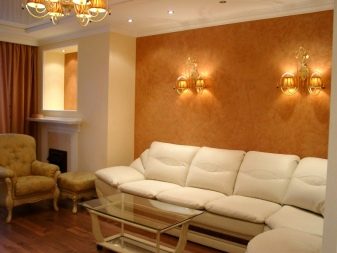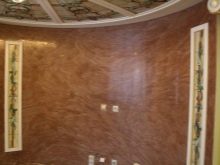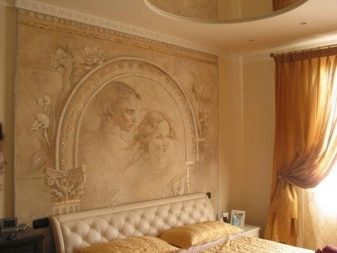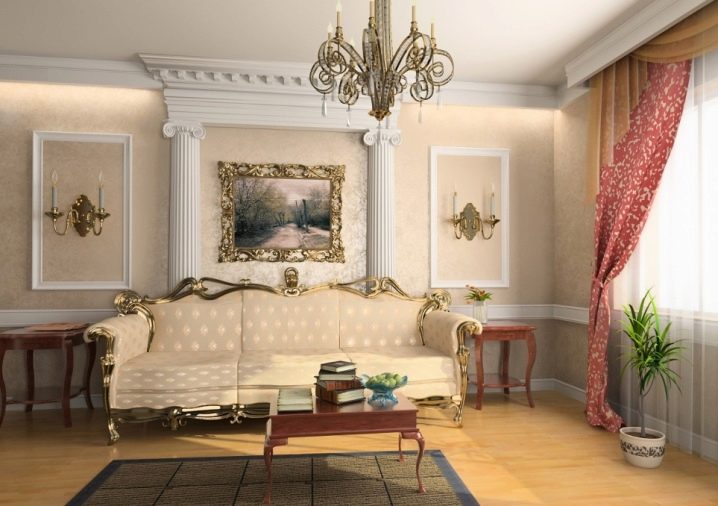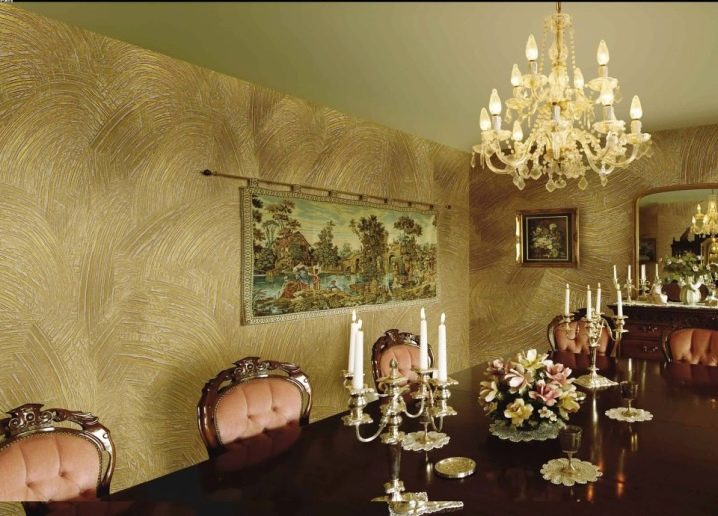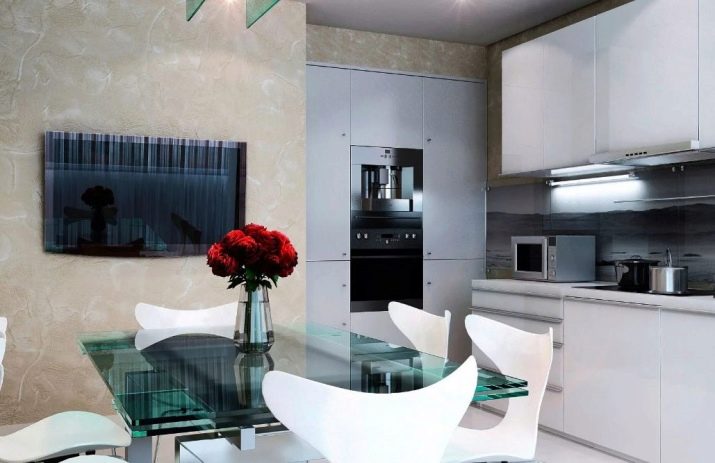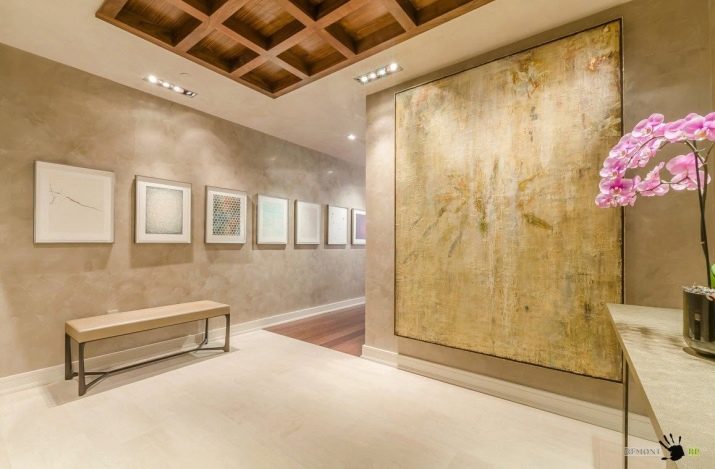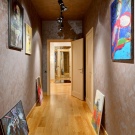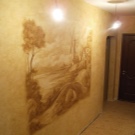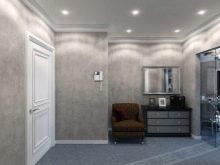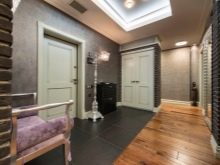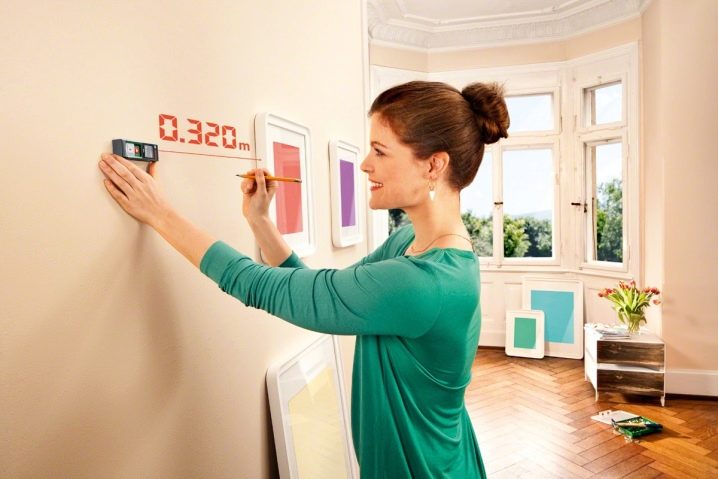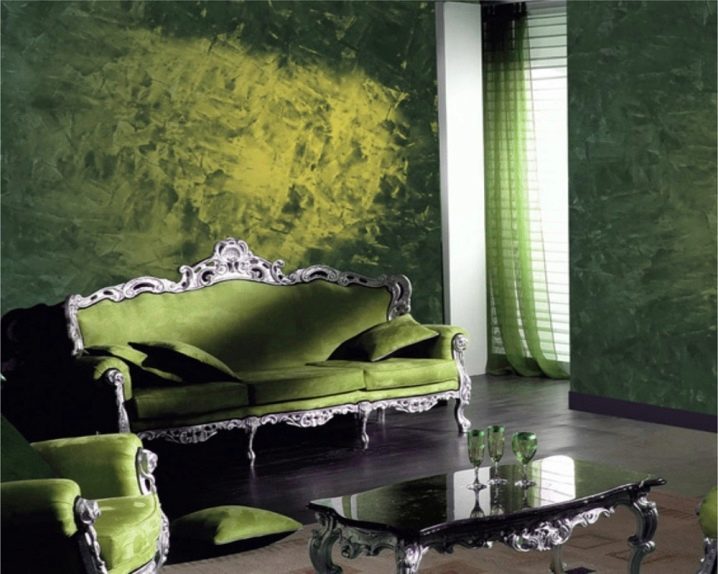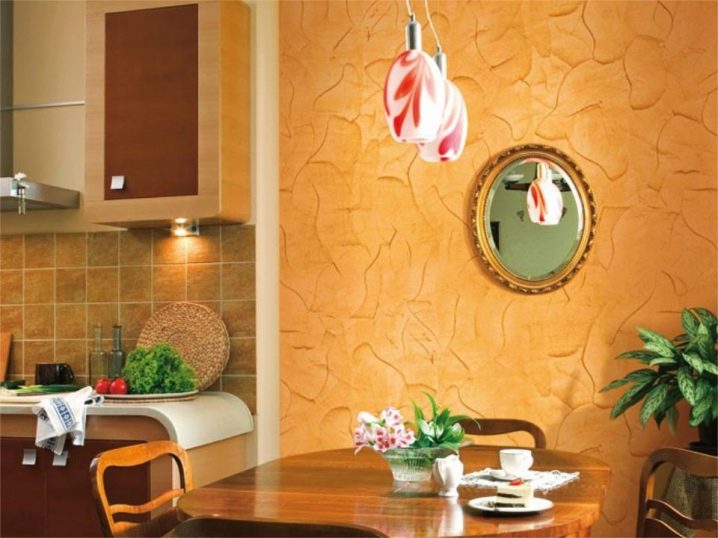Venetian plaster in interior design
The choice of decorative finishing material for walls is a matter of relevance during any repair. Venetian plaster will help to make your interior fashionable, elegant and luxurious. This coating is always relevant and can be done in any color.
Special features
Venetian plaster in its texture, color reproduction is reminiscent of marble. Stone dust is used as the basis of the mixture, which gives such an effect. Depending on the size of the fractions, the final result will vary. The stone is used the following types: granite, quartz, marble, onyx, malachite, limestone. But more often than not it is not a breed, but a mixture of different ones.
Previously, slaked lime was used as a binder,but thanks to modern technology, the composition has changed: acrylic resins and polymers have excellent characteristics, while being safe for human health.
To give the mixture the necessary shade, pigments are added to it. They can be organic and inorganic. In addition to the desired color, the pigment protects the finished surface from burnout and other external influences. After plastering the surface of the wall, it is treated with protective wax, which gives elasticity to the coating and repels dust.
Venetian decor is for interior use only. Gentle material is not created for aggressive environment, temperature changes and high humidity. The required microclimate is a living room, a bedroom, a dining room, a corridor or a hall. For a bathroom and a kitchen apron such material should not be used.
Advantages of Venetian plaster:
- water resistance;
- has good adhesive properties;
- durability: service life - up to 15 years;
- tolerates mild cleaning products;
- does not exfoliate, unlike wallpaper;
- eliminates the discrepancy of the seams, as it does not have them;
- is a material that does not ignite and does not support fire;
- are eco-friendly material;
- does not smell;
- the surface can be repainted or covered with wallpaper, without removing the decorative layer of plaster;
- has excellent decorative properties, harmoniously combined with any pieces of furniture and style.
Disadvantages:
- vapor permeability;
- does not possess frost resistance;
- poorly tolerates temperature drops;
- during the settling of the house, a crack may form on the surface, which cannot be corrected;
- considered expensive material;
- requires a master of a certain skill.
Color spectrum
Initially, such a finishing material for the walls was assumed as a clear imitation of marble. Therefore, the classic options will be the color solutions based on this material: gray, white, emerald, light and rich brown.
For small rooms suitable Venetian plaster of light colors. This color will expand the space, will allow you to admire the coating of walls near.
Bright, unusual colors such as chocolate, lilac, blue, yellow, orange are also very relevant.These walls fit perfectly into the southern and eclectic interiors. Colors can be combined, create transitions, play material depending on the light. An interesting solution may be to insert panels from photo wallpapers.
In addition to color, Venetian plaster complements mother of pearl. Different colors give a different effect in combination with pearlescent modulations. Some blends have a strong glow, and some have a nice light glow.
Venetian plaster is usually ordered in advance, as the point of sales specialist mixes the desired color for a specific individual order. Of course, there are standard color schemes, but to achieve the desired result is possible only after a thorough coloring.
Design
Depending on the composition of the mixture on the surface of the walls when applying Venetian plaster creates a diverse effect. There are types of plaster that are in demand and have excellent external characteristics.
Trevignano
This plaster belongs to the premium class. On the walls, it really looks luxurious. The texture of “Trevignano” very precisely repeats the texture and play of the color of real marble.In addition, the coating does not look cold, pleasant to the touch, velvety, reminiscent of cashmere.
This type of coating is applied to the surface in thin layers., which allows you to create the illusion of marble with its characteristic veins and color effects. If you treat the finished decorative surface with special wax, then Trevignano can be a decoration for the bathroom, but it is better to finish the shower area with a more waterproof material. On sale can be found in packs of 5 and 25 kg.
Veneto
After applying the decorative material creates the effect of a matte finish. This property also appears in polished marble. This type of plaster is very popular due to the simplicity of its application, but despite this it looks very noble. Due to the fact that the coating has no gloss, it is chosen to create male and minimalist designs. Often can be found in the interiors in the style of a loft, hi-tech. Sold in packs of 25 kg.
Marbella
This type of Venetian plaster has roots in Morocco. Such a coating is distinguished by large matte velvety strokes, between which sparkling, brilliant streaks spread in thin streams.This type of plaster is used not only for finishing walls, it can be used for decorating ceilings, columns, cornices, niches. This is achieved due to the high degree of elasticity of the material. In one product package is 7 kilograms of the mixture.
Encausto
This plaster has a complex method of application, which consists of two stages. First, a mixture of “Encausto Premiere” with a mineral filler, which creates a textured surface, is applied, and then a finishing solution based on limestone “Encausto”.
Thanks to such a difficult application, an absolutely amazing effect is obtained: polished marble gets unusual radiant blotches. Silvery shades look noble and strict, warm and golden tones are luxurious and expensive. In one pack - 25 kilograms of solution.
Tierrafino
Tierrafino plaster will be chosen by those who like to be in luxury, who like to create interiors of palaces at home. Such a mixture resembles moire fabric, gilded marble or traventine. It has indescribable words pearl overflow.
Such a method of patinating, which is in demand in the furniture industry for creating classic groups, can be no less elegant for decorating walls or ceilings.
Thanks to a special application technique, it is Tierrafino plaster that creates the popular and trendy “world map” coating effect. There is a package on the market that contains 7 kilograms of the mixture ready for use.
Imperiale
Plaster, worthy palace chambers. The golden pigment mixed into the mixture allows you to achieve pompous luxury of the walls. The pattern is applied in several translucent layers, which allows you to create not just chic, but also complex, sophisticated and shimmering marble drawing, thus confirming that marble is a “shining stone”. In one pack 4 kilograms of ready-mixed.
Due to the large number of possible effects of Venetian plaster, you can create unique interiors that will please the eye for a long time, while remaining relevant. A Venetian woman is well combined with other hotel materials, you can choose interesting combinations and create a room design in any style.
In the palace interiors, you can use coatings of pure colors with mother of pearl and gold pigment, combining with the decoration of natural marble, wood, matte white plastered walls.
In the interior in a loft style, matte versions of steel shades will harmoniously overlap with bricks and lots of metal decor. This choice is also relevant for minimalist designs. Bright, fresh, rich colors with golden streaks are a great solution for oriental interiors.
Which one to choose?
The choice of finishing material for the walls is individual for everyone. However, Venetian plaster is a long-term investment, and not cheap either. That is why it is necessary to approach the issue with great care.
The first task is the definition with the room where the coating will be used. Venetian looks great in large, spacious rooms, for example, in the living room. The hall will acquire palace splendor if gold pigment participates in the mixture or the mother-of-pearl effect is present. Of course, the rest of the interior must comply. The panel with medieval plots, volume crystal chandeliers, curtains with lambrequins, stucco molding will perfectly fit into such a living room.
For modern designs in the style of hi-tech, minimalism, loft is perfect plaster with a matte effect.Marble texture of cool, pastel, natural shades will be an excellent background for creating interiors, in which the main task is to place accents. Large reception such reception is very peculiar. In order not to overload the situation, to allow your eyes to relax, you should choose a matte mixture of concise colors.
For the kitchen, you can create an interesting combination of colors and textures. The dining area can be distinguished, put on it a more relief coating of saturated, “tasty” color, muffle the other walls, thus take your eyes off the working part. In the kitchen, it is important to use waxing coating that will protect against excess moisture.
Neutral palette will be suitable for the halls, preferably light colors, since often this room does not have access to natural light. You can use any texture, but you should not overpay for gold pigment and mother-of-pearl - due to the lack of light, the effect will be lost, and the hall is a passing area of an apartment or house.
In the hallway walls often tend to get dirty. Venetian plaster can be washed, but it quickly absorbs dirt and will have to be pretty hard to bring it to its original appearance, especially if the texture is porous and velvety.The first thing you can do is choose a dark pigment and a smooth surface, the second is to find a way to combine the plaster horizontally, for example, with wall tiles, wood or plastic panels.
Very often in the fashionable design of bathrooms can be found options with plaster. Unlike tiles, plastered walls create comfort, allow you to choose an exceptional color scheme, look fresh and not corny. However, it is better to finish the shower area with tiles or mosaics. In terms of moisture resistance, such materials are not inferior to plaster, and the rest of the walls should be treated with wax.
Tips and tricks
Before you go to the store for a solution, you should make measurements of the room. The amount of work is calculated in meters squared. Almost all Venetian plasters are applied in two stages - the base and finishing layer. The thickness of the first is 0.5-0.9 mm, the thickness of the second is 0.15-0.2 mm. Guided by information about the volume of the mixture of each type in the package, you need to calculate the required quantity for a particular room.
Directly at the point of sale, the consultant will suggest to put the mixture in the desired color.For each solution offers a catalog with a color scheme. Even if the desired shade is missing, you can create your own individual version by mixing several colors.
Buy Venetian plaster should immediately before use. The shelf life of a closed package is 12 months; after the tinting process, the package is considered opened.
Since the solution is already ready for application, it should not be diluted with water, this will damage the finishing material. The mixture should just be well mixed.
Independent application is possible after thorough theoretical preparation., as well as having experience finishing work. You should not try decorative plastering if there is no certainty about the final result. You should also study the instructions for applying to specifically selected plaster: for example, in the technical description of the mixture of Marbella indicated the need for two masters during the application of layers, as the plaster dries quickly.
It is important that the surface of the base is smooth and clean. Before applying the decorative mixture, the walls are treated with special acrylic impregnation.
The marble texture is formed by a special Venetian trowel.There are different types of spatulas designed for this. Required is the availability of tools for corner work.
First a base, white layer is applied. It serves as a backdrop for finishing decorative application. Thanks to the first layer, the effect of transparency of the coating is created, the wall seems to shine through.
Some types of plasters require the creation of a specific texture at the base stage. Textured strokes need to be created by one master so that all walls are treated equally. The final effect depends largely on "how the hand took."
Applying a coat of color is considered the second stage.and it is produced in 8-12 hours. Some mixtures, for example, Trevignano, imply filling up to 12 layers, each of which is ground and subjected to ironing. This creates a complex, multifaceted pattern, acquires a special spatial effect.
After the plaster has dried (1-2 weeks), you can begin to apply a protective wax. It is also applied with a spatula in two layers, each of which dries for 12-24 hours. At the end of the surface is polished to a shine.
Beautiful examples in the interior
The mirror gloss of decorative Venetian plaster “Trevignano” perfectly imitates the surface of marble. Thanks to the reflective surface of the walls of the room expands, and the walls themselves seem to be transparent and weightless.
Imperiale plaster has a golden pigment. Gold and malachite - a combination worthy of palace chambers. A luminous, sparkling effect can be obtained with a different color scheme, if saturated and bright green seems too bold.
Large “Marbella” strokes are a great option to give the room texture. This texture can not be achieved either wallpaper or any other finishing materials. The wall, made of Moroccan plaster, does not require additional decorative elements, she herself is an object of art.
You can watch a master class in applying StukPalais Venetian plaster in the next video.










